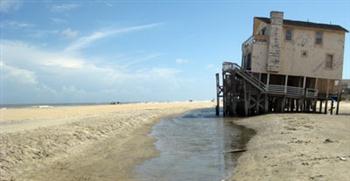By Rob Morris and Frank Tursi
RALEIGH — Two recent court cases – one dealing with mega-dumps and the other with the public-trust beach – may have far-reaching implications for coastal environment protection.
In the first case, the N.C. Court of Appeals ruled two weeks ago that a 2007 law enacted by the N.C. General Assembly, which put limitations on the location and size of landfills, doesn’t discriminate against out-of-state waste.
Supporter Spotlight
Waste Industries USA had challenged the legislature’s authority to enact the law. The N.C. Coastal Federation and the N.C. Sierra Club, represented by the Southern Environmental Law Center, intervened in the case to defend the law. The state chapter of the NAACP and Rogers-Eubanks Neighborhood Association also intervened.
The state law imposes additional restrictions on the size and location of solid-waste landfills, including buffers from environmentally sensitive lands. Waste Industries claimed that those restrictions unlawfully prohibited a proposed landfill that the company had planned to build in Camden County. The N.C. Department of Environment and Natural Resources denied the permit application for the proposed landfill because it was within buffers established by the law to protect a wildlife refuge and a state park.
“The court affirmed the legislature’s authority to act on behalf of residents by protecting our environment and the public health from the adverse impacts of improperly sited and excessively large landfills,” said Chandra Taylor, a lawyer with the Southern Environmental Law Center.

The N.C. Appeals Court held that beach towns can’t condemn houses on the public-trust beach. Only the state can, the court ruled. |
The restrictions on siting these huge landfills are vital to protect the coast’s most environmentally sensitive lands, noted Todd Miller, executive director of the federation. “Without these restrictions, landfills could be located in proximity to parks, wildlife refuges and game lands that are used and enjoyed by many of our citizens,” he said.
Supporter Spotlight
In another important case, Nags Heads is seeking to appeal to the state Supreme Court a lower court ruling that it has no jurisdiction to order the removal of “nuisance structures” blocking what is known as the public trust beach. The N.C. Court of Appeals had ruled in February that only the state has the power to enforce North Carolina’s public trust doctrine.
Along the state’s beaches, that common-law doctrine applies to the area of sand between the toe of the dune line and mean high water that anyone is allowed to use, even if it’s privately owned. Think of it as state-owned right-of-way.
Though the case arises from Nags Head’s condemnation of beachfront houses threatened by erosion, the ruling calls into question local power to create and enforce ordinances regulating dogs, beach driving, smoking and the like.
Because of its potentially far-reaching implications, coastal communities are lining up behind Nags Head as it seeks a hearing on its power to enforce state law along the town’s beaches.
Dare County was the latest, unanimously endorsing the resolution a couple of weeks ago. It says the state historically has given local governments broad authority to protect the condition and use of the public trust beach.
For more than two years, Nags Head officials have battled property owners whose houses seemed on the verge of toppling into the ocean. Before a beach re-nourishment project last year, the ocean routinely washed under the houses and debris littered the sand around them.
A row of eight houses along Seagull Drive in South Nags Head — where erosion had consumed the beach past the dune line — became the focus of the legal conflict.
Town Manager Cliff Ogburn declared all eight nuisances because they were in the public trust right-of-way. Six of them also were considered dangerous because of their dilapidated condition.
One of the houses, which is owned by Cherry Inc., was at the center of the Supreme Court petition.
Lance Goldner, president of Cherry, said the town was wrong in saying that the cottage was in serious disrepair, dangerous and uninhabitable. He said the house lost some steps, drain lines for the septic field and water and electricity connections after a storm in November 2009.
“Otherwise the (dwelling) is in habitable condition and is not suffering from any structural defects that would make it unsafe,” Goldner said in an affidavit.
Goldner contended that the town had blocked Cherry’s efforts to obtain permits to make repairs and that the Dare County Department of Public Health had approved a permit for upgrading the septic system.
Although beach re-nourishment put plenty of beach in front of the row of houses, most are visibly beyond repair. One lists precariously on its pilings.
Ogburn said in an interview that the state Attorney General and the state Department of Environment and Natural Resources have agreed that localities can determine matters affecting the public trust beach.
At one time, as many as 26 houses were considered nuisances. All but those on Seagull have been removed from the list. They are no longer in the right-of-way, or they have been torn down or moved, Ogburn said.
Depending on what happens in the court system, legislators will probably be asked to consider a measure that would clarify the public trust question.
Some information for this story was provided courtesy of The Outer Banks Voice, an online newspaper on the Outer Banks. Coastal Review Online is partnering with the Voice to provide readers with more stories of coastal interest.







